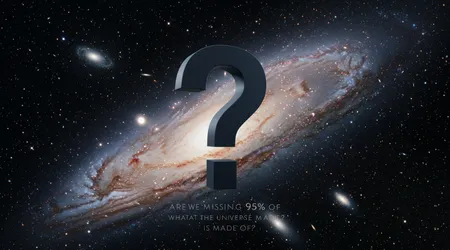Are We Missing 95% of What the Universe Is Made Of?

It’s the most humbling, terrifying, and exhilarating question in modern cosmology: Are We Missing 95% of What the Universe Is Made Of? The universe we observe everything from the stars in the Milky Way to the atoms in our bodies accounts for a mere five percent of the total cosmic inventory.
Anúncios
The remaining 95% is composed of two invisible, mysterious entities: Dark Matter and Dark Energy. This vast unknown fundamentally challenges our most established theories of physics. It forces us to acknowledge that our current understanding of reality is profoundly incomplete.
We stand on the precipice of a new era of discovery, where the unseen dictates the fate of everything we can see. Understanding this cosmic discrepancy is paramount to unlocking the true nature of space, time, and existence itself.
The Dark Matter Paradox: The Cosmic Glue We Can’t See
Dark Matter is the invisible scaffolding holding galaxies together. Its existence is not theoretical speculation; it is an observational necessity derived from how things move in the cosmos.
The Galactic Speed Limit Problem
Astronomers first detected the influence of Dark Matter by observing galactic rotation curves. Galaxies spin much faster than the visible matter within them suggests they should.
According to classical physics, stars on the outer edge of a galaxy should orbit much slower than those near the center. Yet, observations show these outer stars orbit at nearly the same velocity as the inner stars, a cosmic speed limit violation.
This uniform speed implies an enormous gravitational presence we cannot see. An invisible mass must surround the galaxy, providing the extra gravitational pull to keep the faster-moving outer stars from flying into intergalactic space.
This extra gravity is what we define as Dark Matter. We cannot detect it through electromagnetic radiation it emits no light, absorbs no light, and reflects no light.
This stark observational data provides the first powerful evidence for the question: Are We Missing 95% of What the Universe Is Made Of?
++ Unveiling the Dark Beads over Saturn: What Are They?
The Gravitational Lensing Distortion
Another compelling piece of evidence comes from gravitational lensing. Massive objects warp the fabric of spacetime, bending the light of objects behind them.
Astronomers use the distortion of background galaxies to map the mass distribution of foreground galaxy clusters. These maps consistently show that the gravitational effect is far stronger than the visible mass of the galaxies suggests.
The observed light distortion confirms a massive, unseen halo of material surrounds these clusters. This hidden mass, Dark Matter, forms the gravitational backbone of the largest cosmic structures.
The precise mapping of this lensing effect has solidified Dark Matter’s role as the universe’s unseen architect.

Dark Energy: The Force That Tears Space Apart
If Dark Matter is the hidden cosmic glue, Dark Energy is the antithesis: a repulsive force pushing the universe apart at an accelerating rate. Its discovery was entirely unexpected, upending decades of cosmological thought.
The Accelerating Expansion Enigma
The existence of Dark Energy was deduced from observations of Type Ia Supernovae in the late 1990s. These “standard candles” are crucial tools for measuring cosmic distances.
Researchers expected the expansion of the universe, initiated by the Big Bang, to be gradually slowing down due to gravity. The gravity from all the matter, including Dark Matter, should be hitting the cosmic brakes.
The startling discovery was the opposite: the expansion is accelerating. The distant supernovae were moving away from us faster than predicted, indicating an unseen force counteracting gravity. This repulsive force permeates all of space.
This phenomenon, dubbed Dark Energy, accounts for nearly 70% of the entire mass-energy density of the cosmos. Its immense power makes us ask again: Are We Missing 95% of What the Universe Is Made Of?
Also read: Could the Universe Reboot in a Cosmic Bounce?
Vacuum Energy and the Cosmological Constant
The nature of Dark Energy remains the deepest mystery in physics. The leading theoretical candidate is the Cosmological Constant, first proposed (and later retracted) by Albert Einstein.
This theory suggests Dark Energy is the energy inherent to the vacuum of space itself. As the universe expands, more vacuum is created, leading to more Dark Energy and thus faster acceleration a runaway positive feedback loop.
However, quantum field theory predicts a vacuum energy density vastly greater than what is observed off by a staggering factor of .
Read more: What If Black Holes Are Actually Holograms?
This monumental discrepancy is arguably the biggest unsolved problem in physics. This suggests our fundamental equations of space and energy are drastically flawed.
The Search for the Unseen: Current Scientific Endeavors
Scientists are not passively accepting this 95% gap. Global collaborations are employing ingenious methods to hunt for direct evidence of Dark Matter particles and understand Dark Energy’s properties.
The Underground Hunt for Dark Matter
Since Dark Matter interacts only gravitationally and weakly (if at all) through the weak nuclear force, detecting it requires extreme sensitivity and isolation. Large detectors are buried deep underground in former mines to shield them from cosmic rays and background noise.
The primary target is the WIMP (Weakly Interacting Massive Particle). Detectors like the LUX-ZEPLIN (LZ) Experiment in South Dakota, utilizing tons of liquid xenon, wait for a WIMP to collide with a xenon nucleus. Such a collision would produce a tiny flash of light or ionization signal.
So far, these experiments have yielded no confirmed WIMP detections. This continued null result suggests the Dark Matter particle may not be the WIMP, forcing physicists to explore exotic new candidates, such as the lightweight axion. This lack of direct contact deepens the mystery of Are We Missing 95% of What the Universe Is Made Of?
Mapping the Dark Universe
To better understand Dark Energy, large-scale surveys are mapping millions of galaxies to measure the expansion rate with unprecedented precision. The Dark Energy Spectroscopic Instrument (DESI), for example, is building the largest 3D map of the universe.
By observing how the distribution of galaxies (specifically Baryon Acoustic Oscillations, or BAOs) changes over cosmic time, DESI is providing a cosmic ruler to precisely gauge the history of the universe’s acceleration.
This data will either confirm the simple Cosmological Constant model or point toward a more complex, time-varying Dark Energy known as “quintessence.”
The detailed and continuous mapping efforts, like those undertaken by the Euclid Satellite Mission, are crucial.
Euclid’s sharp images of billions of galaxies will allow scientists to detect subtle gravitational lensing effects, creating the most precise map yet of the Dark Matter distribution throughout the cosmos.
The Cosmic Balance Sheet: The Universal Inventory
Our current cosmological model, the CDM model (Lambda-Cold Dark Matter), provides the most accurate breakdown of the universe’s total energy density.
This model is currently the “best fit” for all observational data, including the Cosmic Microwave Background (CMB) radiation.
| Component | Percentage of Total Mass-Energy | Observational Evidence |
| Dark Energy | ≈68.3% | Accelerating expansion (Type Ia Supernovae) |
| Dark Matter | ≈26.8% | Galactic rotation curves, Gravitational Lensing |
| Normal (Baryonic) Matter | ≈4.9% | Stars, planets, gas, everything visible |
Statistic: According to the final analysis data from the Planck satellite mission (2018, still the gold standard), the universe consists of only normal matter. This means the vast bulk of remains elusive.
Analogy: Thinking about this cosmic composition is like examining a highly influential company. We see the products and the visible staff (), but the true power, the financial reserves, and the engine of growth ) are hidden in offshore accounts and secret R&D labs.
We are trying to understand the company’s fate by only looking at the visible front desk. This highlights the magnitude of the question: Are We Missing 95% of What the Universe Is Made Of?
Conclusion: The Unfinished Map of Reality
The knowledge that Are We Missing 95% of What the Universe Is Made Of? is a profound testament to the limits of our current physics. Dark Matter and Dark Energy are not simply missing pieces; they are fundamental flaws in our existing Standard Model.
They signal the urgent need for a new physics, one that incorporates these invisible entities not as afterthoughts, but as foundational components of reality. Every failed detection and every refined measurement narrows the search parameters, bringing us closer to a revolutionary discovery.
The next decade, armed with powerful new telescopes and underground labs, promises to crack this cosmic code. The answers, wherever they lie, will change our understanding of everything.
We are the generation living on the edge of this greatest cosmic revelation. What radical new theories do you believe will finally unify the visible and the dark universe? Share your insights and perspectives in the comments below.
Frequently Asked Questions
Could Dark Matter just be regular matter (like black holes) that we haven’t seen yet?
This idea is largely ruled out. Normal (baryonic) matter interacts strongly with light. Cosmological models, based on Big Bang nucleosynthesis, precisely predict the total amount of normal matter that could have been created. That predicted amount perfectly matches the we observe.
Therefore, Dark Matter cannot be explained by ordinary black holes or burnt-out stars; it must be a fundamentally different type of particle that does not interact via the electromagnetic force.
How do we know Dark Energy isn’t just a misinterpretation of gravity?
The alternative explanation is that Einstein’s theory of General Relativity, which describes gravity, is incorrect or incomplete on cosmic scales. Scientists are actively testing Modified Newtonian Dynamics (MOND) and other modified gravity theories.
While MOND can sometimes explain the rotation of individual galaxies without Dark Matter, it fails to consistently explain observations at the larger scale of galaxy clusters and the overall cosmic expansion.
The current consensus is that a new form of energy (Dark Energy) is a better fit for the full range of astronomical data. This emphasizes how challenging the question Are We Missing 95% of What the Universe Is Made Of? truly is.
If Dark Matter and Dark Energy are invisible, what makes them “dark” and not just “missing”?
They are called “dark” precisely because they don’t interact with the electromagnetic spectrum they are literally dark to our instruments.
They are not merely “missing”; their presence is inferred and mathematically required to explain gravitational effects (Dark Matter) and the accelerated expansion of space (Dark Energy).
Without them, our cosmic maps and equations fail completely. Their required gravitational and energetic effects confirm that Are We Missing 95% of What the Universe Is Made Of is an essential fact, not a theoretical gap.
